It’s Friday, October 7th, 2005. The Apatovian Age has begun, with The 40-Year-Old Virgin still dominating the box office, but you might instead be going to see Serenity if you’re a certain sort of geek or A History of Violence if you’re a different sort of geek. Every passing Hummer H2 and candy-colored PT Cruiser is blasting Late Registration or The Emancipation of Mimi and everyone is wearing the lowest-rise jeans or largest cargo shorts imaginable. The news out of Afghanistan is, as ever, appalling, but the wartime economy is booming, bolstered by creative high-risk lending to homeowners with poor credit. You’ve got brain-training games on your Nintendo DS, a fridge full of Red Bull, and nothing to do but draft Ravnica: City of Guilds all weekend.
Nostalgia is a poison, but so’s alcohol–stick to small, infrequent doses and you’ll probably be alright. Personally, Ravnica through Eventide was my favorite era of Magic (with Scars of Mirrodin through Return to Ravnica as a runner-up), and I’m incapable of viewing it without the intoxicating effects of nostalgia. From an objective perspective, the three sets are full of outmoded designs and unplayable cards, from Frazzle to Dread Slag to Barbarian Riftcutter, but when you’ve known someone for 18 years, you tend to forget the Benediction of Moons.
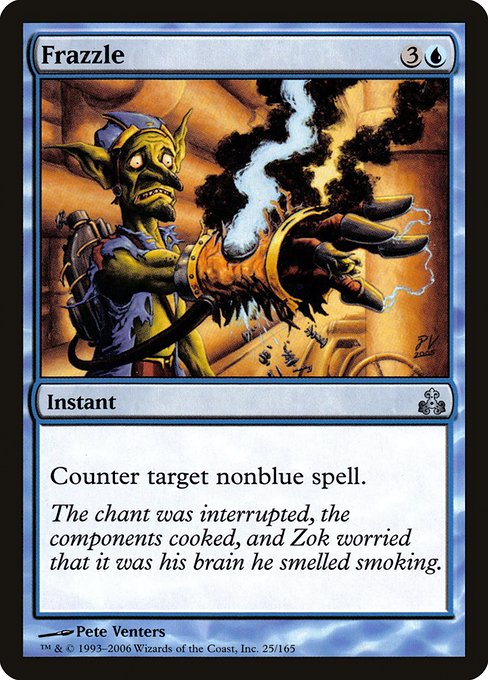
Ravnica has scripted what Magic became so indelibly, from the dramatic increase of multicolored cards in modern sets to the mana bases we expect in tournament Magic to the philosophies each color pair espouses that still shapes Magic’s most popular format. But first, Ravnica had to hit its target after a rocky couple of years for Magic, and to both reinvent the multicolored block after Invasion’s successes and bridge a mono-colored Kamigawa Standard to a truly bizarre Time Spiral/Coldsnap Standard, to take us from Umezawa’s Jitte-enabled aggro decks to wild Ghost Dad and Solar Flare decks.
Ravnica introduced hybrid mana, which was deceptively deep. From a mechanic perspective, it’s incredibly simple: a hybrid cost of X/Y can either be paid with X or Y. Shadow of Doubt, for example, can be cast for UU, BB, or UB. From a design standpoint, as Mark Rosewater has often mentioned, it’s difficult–while multicolored cards are about the fusion of two (or more) colors, hybrid cards are about the overlap of what those colors can do. That’s a pretty narrow target to hit–Blue can bounce and White can exile, but a hybrid Blue/White card that exiles a creature would feel strange in a mono-Blue deck. So Ravnica’s hybrid cards were mostly very staid designs–Centaur Safeguard could easily cost either 2G or 2W or even 1WG. By making it hybrid, though, Wizards could make it attractive to Golgari decks that sacrificed creatures for benefits and for Orzhov decks that cared about lifegain.
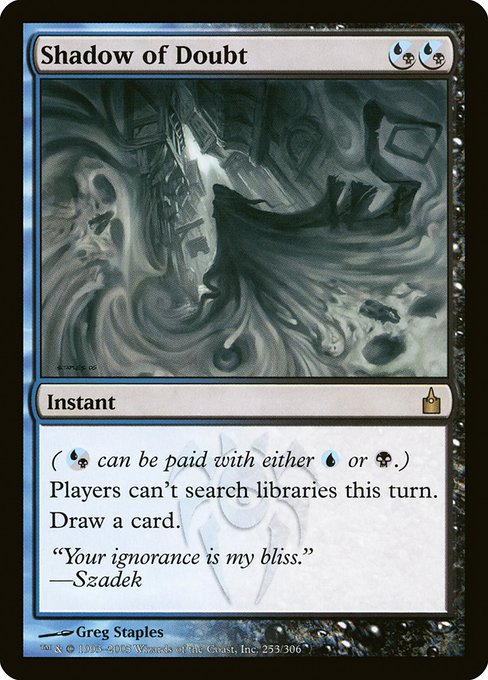
It was a brilliant move that helped streamline Limited–a card like Boros Recruit might read like a Boros card for obvious reasons, but Gruul appreciated a one-drop to turn on Bloodthirst and Selesnya wanted a cheap convoker. Hybrid was conservatively deployed in Ravnica Block, with few hybrid cards crossing over to tournament play, but it was an unmitigated success, returning quickly in Shadowmoor/Eventide and Shards of Alara, as well as all subsequent Ravnica-based sets. Wizards showcased it from the start, with the Prerelease promos of Gleancrawler, Djinn Illuminatus, and Avatar of Discord. While tame by modern standards, all three of these cards were exciting to the more casually-minded (or the tournament strivers in the case of the Avatar, although it didn’t end up being worth Mind Rotting yourself) players back in 2005. The Guildmages were especially crucial as flexible Limited cards that were able to fit into multiple pairings–you had one preferred mode (the +2/+2 mode on Gruul Guildmage, for example) and one that was less critical, so a Simic deck could snap up an early Dimir Guildmage and basically ignore the discard effect.
Most of Ravnica’s most exciting cards, as we’ve discussed, have been reprinted several times in the intervening decades, but even in that cadre, there are cards worth discussing. The block affected Magic from Vintage, where Flame Fusillade went immediately infinite with Time Vault, to Char reinventing Psionic Blast and subtly previewing Planar Chaos’ color-switching gimmick over a year before that set dropped, to Transmute giving even Pauper decks tutors to Infernal Tutor reshaping Legacy and saving Lion’s Eye Diamond from a perennial slot on various “worst cards ever printed” lists. To truly give Ravnica its due would require more than just two articles–luckily, we’ll be returning to the block (and other Ravnica sets) in January, and we’ll have plenty to talk about. In the meantime, let’s remember some cards:
Galvanic Arc
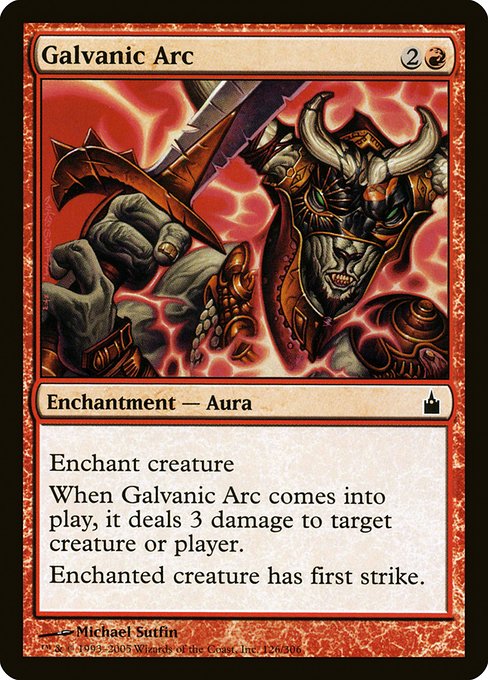
Galvanic Arc: This unassuming Limited standout is emblematic of why Ravnica was a success across the board: long before “FIRE design” or even “New World Order design,” Ravnica was printing interesting effects at common. Galvanic Arc was a fine pick in Boros/Rakdos/Gruul decks, offering a Sorcery speed Carbonize, but it truly shone in Izzet in conjunction with Drake Familiar. No one wanted the Familiar unless they had snagged an early Arc, but once you did, you drafted Flight of Fancy and any other Arcs you saw and looped them for maximum benefit. The deck was easily disrupted, but also one of the most fun things you could do in Limited–and since all the pieces were commons, in triple-Ravnica, you could nail it frequently. My only issue with Galvanic Arc is the same I have with cards like Bedlam: they reference real-world, Earthbound places and people–in this case, Luigi Galvani. Even then, I can let that slide, because if there’s a plane where I can imagine an Italian inventor experimenting with frogs and electricity, it’s undoubtedly Ravnica.
Chord of Calling
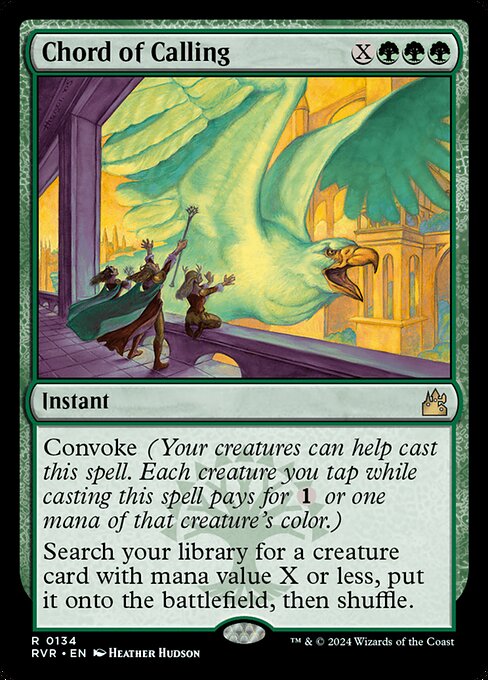
Chord of Calling: 1997’s Visions brought us Natural Order, the core of the “Secret Force” deck that Jamie Wakefield popularized for Extended. The deck ran a ton of explosive mana, including Priest of Titania and Gaea’s Cradle, to power out a turn three Verdant Force. If that didn’t work out, you could tap and sacrifice a Fyndhorn Elves on turn three to Natural Order out a Force instead. Chord of Calling isn’t quite as explosive as Natural Order, as you have to have enough creatures and/or lands to hit XGGG, but being able to tutor for silver bullets has been historically incredible, whether it was Loaming Shaman in 2006 Standard or Yawgmoth, Thran Physician to combo out in today’s Modern. By casting cost, Chord is fair–but any card that lets you flip your entire deck over and skim out a threat is inherently dangerous. We wouldn’t have Green Sun’s Zenith without Chord of Calling, which has proven itself to be a more exploitable version of the effect.
Ghost Council of Orzhova
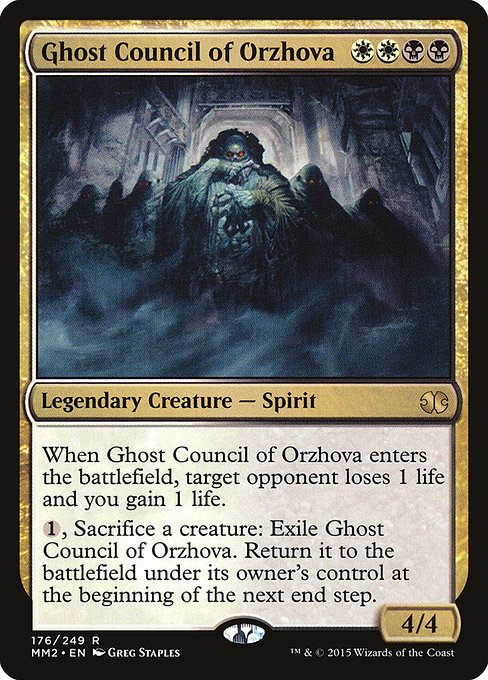
Ghost Council of Orzhova: If you ask for Ravnica Block’s main contributions to tournament Magic, people will rightly say Dark Confidant or the shocklands or Dredge. All true enough, but as a midrange mage, the best part of Ravnica was the Baloth-sized beaters. Suddenly, we were getting incredible numbers of 4/4’s for four, from Cytoplast Root-Kin to Moroii to Loxodon Hierarch to my personal favorite, Ghost Council of Orzhova.* Long before Karlov or Obzedat were around, this four-drop was the centerpiece of one of the most beautiful Standard decks: Ben Goodman’s “Ghost Dad.” The deck’s engine was using Shining Shoal and Sickening Shoal with a Tallowisp out to tutor up copies of Pillory of the Sleepless. It was a synergy-driven deck that employed Limited-only cards like Thief of Hope and Pillory, along with the Ghost Council itself, to drain opponents out one ping at a time and could sacrifice creatures at will to counteract Umezawa’s Jitte. Like Mardu Aristocrats, it was a collection of mediocre cards that came together as one glorious machine, and it wouldn’t have been possible without the paternal phantom itself. I’ve tried to make it work in Modern, but it’s simply not functional outside of the context of that specific Standard. Ghost Council, too, is a bit undersized/undertriggered in a world of pitch Elementals and damage no longer using the stack, but I’ll always remember it as a threat circa 2006.
Grozoth
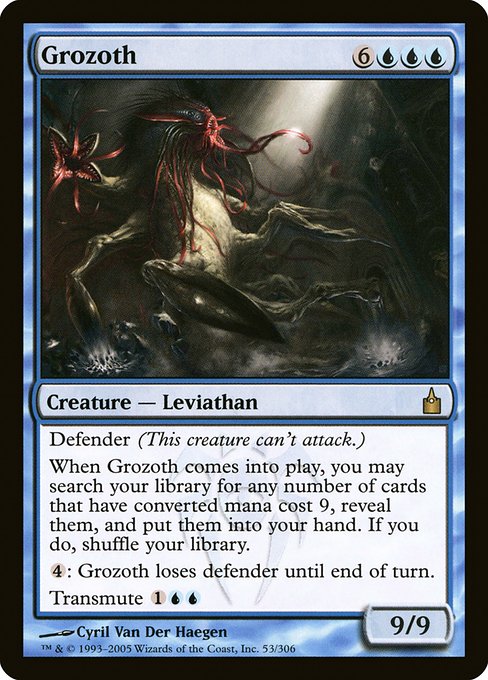
Grozoth: At the time, one of the weirdest cards printed. Grozoth, along with Ravnica’s Autochthon Wurm, was the centerpiece of casual-only decks running Kaboom!. In Standard, some maniacs ran Grozoth with a wad of Signets as a way to grab a bunch of Fifth Dawn’s Bringers (e.g., Bringer of the Black Dawn, but they never went anywhere, although some Dragonstorm variants used it as a backup copy of the deck’s namesake. In the modern age, though, with the dominance of Commander, Grozoth has come into its own. Now, you can fetch almost a hundred cards, from Artisan of Kozilek to Portal to Phyrexia to Void Winnower–quite a different proposition from Transmuting for Colossus of Sardia. In a Reanimator deck, Grozoth can do serious work if you’re willing to warp your mana curve to prioritize nine-drops–in 2005, that was foolish. In 2023, that means running cards with built-in cost reduction effects, like Blasphemous Act, Blast-Furnace Hellkite, Cavern-Hoard Dragon, The Great Henge, and Sorcerous Squall.
Hunted Cycle
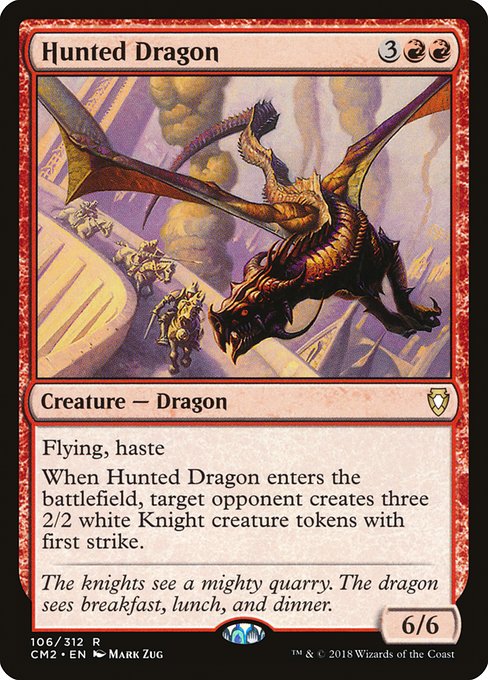
The Hunted Cycle (Hunted Lammasu, Hunted Phantasm, Hunted Horror, Hunted Dragon, Hunted Troll): The hours I spent trying to curve Hunted Troll into Rolling Spoil on Magic Online in 2005 are arguably wasted hours, and yet, no hour that leads to the thrill of landing the “combo” can be truly wasted. Over the years, I’ve tried pairing Hunted Horror with Torpor Orb, Hunted Phantasm with The Meathook Massacre, and Hunted Dragon with “ignoring their tokens and swinging in for six.” Only the last ever bore fruit, and the Dragon did see a bit of play as a top-end for Red decks and Dragonstorm decks in 2006, but the challenge of the other four remains unmet. Inspired by Apocalypse’s Haunted Angel, this cycle was designed for multiplayer–right as multiplayer was preparing to transition from the 4-copies-of-each-card kitchen table Magic to all Commander all the time. Still, the inspiration continues through into the Commander age–compare Hunted Troll to Throne of Eldraine’s Clackbridge Troll. Stats inflation may have hit our Trolls, but there’s still a challenge inherent in Clackbridge Troll.
Ravnica was an unequivocal success by sales metrics, player interest, and design/development innovation, with many of its mechanics and philosophies resonating through today. We may never see Haunt, Transmute, or Radiance again and we surely won’t see Dredge return in any real sense, but Bloodthirst, Convoke, and Replicate have all come back, and other mechanics (like Hellbent becoming Amonkhet’s “heckbent” threshold of one or fewer cards in hand instead of zero) have been inspired by Ravnica’s success. We’ve returned to Ravnica several times over the last eighteen years, with January bringing the victory lap of Ravnica Remastered and retro-bordered shocklands and borderless treatments of iconic cards from the three Ravnica blocks.
The irony of Ravnica Remastered, of course, is that the best cards from the original Ravnica are so elegant and so popular that they’ve been reprinted many times in the intervening years, somewhat diluting their value and perceived power: Leyline of the Void, Dark Confidant, Doubling Season, the shocklands–while these are always welcome in a booster pack, they’re so well designed that they have become benchmarks rather than highlights. Once you’ve seen a Loxodon Hierarch, it’s hard to go back to Ravenous Baloth; once you’ve seen Questing Beast, it’s hard to go back to Hierarch. It’s all part of the evolution of the game–as the years pass, the cards that were once innovative become obsolete. Maybe in another 18 years, we’ll be reminiscing about when Sheoldred, the Apocalypse was format-defining rather than nostalgia bait, and, if Magic survives that long, it will be partially due to the precedent set by Ravnica.
*Although I do wonder if Grave-Shell Scarab was ever a 4/4 for 2BG to mirror Loxodon Hierach. With damage still going on the stack at the time, meaning you could block a 5/4 and sacrifice it to still kill that 5/4 and draw a card, it might have been too overpowered. Since it proved underpowered, though, it probably would have been fine.
Rob Bockman (he/him) is a native of South Carolina who has been playing Magic: the Gathering since Tempest block. A writer of fiction and stage plays, he loves the emergent comedy of Magic and the drama of high-level play. He’s been a Golgari player since before that had a name and is never happier than when he’s able to say “Overgrown Tomb into Thoughtseize,” no matter the format.

